Prolonged hyperphagia with high-fat feeding contributes to exacerbated weight gain in rats with adult-onset obesity
- PMID: 18596107
- PMCID: PMC2536857
- DOI: 10.1152/ajpregu.00727.2007
Prolonged hyperphagia with high-fat feeding contributes to exacerbated weight gain in rats with adult-onset obesity
Abstract
Leptin-resistant rats, when given a high-fat (HF) diet, have a delayed normalization of caloric intake and greater weight gain than those on a chow diet. Because aged, obese rats are leptin resistant, these data predict that they will also have a delayed normalization of caloric intake and exacerbated weight gain when provided a HF diet. To investigate this hypothesis, along with the consequences of a HF diet on voluntary wheel running, we compared various ages of rats on a HF or chow diet. HF-fed young rats spontaneously divided into diet-induced obese and diet-resistant rats. However, all aged rats were susceptible to the weight-gaining effects of HF feeding. Rate of initial weight gain was proportional to age, and peak caloric intake on the HF diet and the days required to normalize caloric intake to basal levels increased with age. Responsiveness to peripheral leptin before HF feeding revealed a dose-response decrease in food intake and body weight in the young but no responses in the aged to even the highest dose, 0.5 mg/day. In addition, both age and HF feeding decreased the tendency for wheel running, suggesting the propensity for inactivity with age and HF feeding may contribute to age-related obesity and accelerate the rate of diet-induced obesity. These results demonstrate that aged rats are more susceptible to the detrimental effects of a HF diet.
Figures
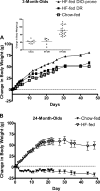

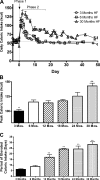
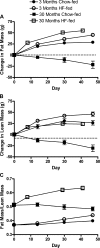
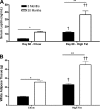

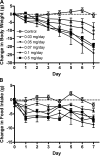
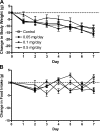
Similar articles
-
The act of voluntary wheel running reverses dietary hyperphagia and increases leptin signaling in ventral tegmental area of aged obese rats.Gerontology. 2011;57(4):335-42. doi: 10.1159/000321343. Epub 2010 Sep 24. Gerontology. 2011. PMID: 20881371 Free PMC article.
-
Leptin resistance: a prediposing factor for diet-induced obesity.Am J Physiol Regul Integr Comp Physiol. 2009 Mar;296(3):R493-500. doi: 10.1152/ajpregu.90669.2008. Epub 2008 Dec 17. Am J Physiol Regul Integr Comp Physiol. 2009. PMID: 19091915 Free PMC article. Review.
-
Leptin antagonist reveals that the normalization of caloric intake and the thermic effect of food after high-fat feeding are leptin dependent.Am J Physiol Regul Integr Comp Physiol. 2007 Feb;292(2):R868-74. doi: 10.1152/ajpregu.00213.2006. Epub 2006 Oct 5. Am J Physiol Regul Integr Comp Physiol. 2007. PMID: 17023670
-
Responses to the cannabinoid receptor-1 antagonist, AM251, are more robust with age and with high-fat feeding.J Endocrinol. 2009 Nov;203(2):281-90. doi: 10.1677/JOE-09-0210. Epub 2009 Aug 13. J Endocrinol. 2009. PMID: 19679649
-
Effect of topiramate on body weight and body composition of osborne-mendel rats fed a high-fat diet: alterations in hormones, neuropeptide, and uncoupling-protein mRNAs.Nutrition. 2000 Oct;16(10):967-75. doi: 10.1016/s0899-9007(00)00451-2. Nutrition. 2000. PMID: 11054603 Review.
Cited by
-
Simultaneous introduction of a novel high fat diet and wheel running induces anorexia.Physiol Behav. 2012 Feb 28;105(4):909-14. doi: 10.1016/j.physbeh.2011.11.011. Epub 2011 Nov 13. Physiol Behav. 2012. PMID: 22115947 Free PMC article.
-
The act of voluntary wheel running reverses dietary hyperphagia and increases leptin signaling in ventral tegmental area of aged obese rats.Gerontology. 2011;57(4):335-42. doi: 10.1159/000321343. Epub 2010 Sep 24. Gerontology. 2011. PMID: 20881371 Free PMC article.
-
Leptin resistance: a prediposing factor for diet-induced obesity.Am J Physiol Regul Integr Comp Physiol. 2009 Mar;296(3):R493-500. doi: 10.1152/ajpregu.90669.2008. Epub 2008 Dec 17. Am J Physiol Regul Integr Comp Physiol. 2009. PMID: 19091915 Free PMC article. Review.
-
Mice lacking GPR3 receptors display late-onset obese phenotype due to impaired thermogenic function in brown adipose tissue.Sci Rep. 2015 Oct 12;5:14953. doi: 10.1038/srep14953. Sci Rep. 2015. PMID: 26455425 Free PMC article.
-
Region-specific diet-induced and leptin-induced cellular leptin resistance includes the ventral tegmental area in rats.Neuropharmacology. 2011 Feb-Mar;60(2-3):480-7. doi: 10.1016/j.neuropharm.2010.11.002. Epub 2010 Nov 5. Neuropharmacology. 2011. PMID: 21059361 Free PMC article.
References
-
- Ahima RS, Flier JS. Leptin. Annu Rev Physiol 62: 413–437, 2000. - PubMed
-
- Carter CS, Cesari M, Ambrosius WT, Hu N, Diz D, Oden S, Sonntag WE, Pahor M. Angiotensin-converting enzyme inhibition, body composition, and physical performance in aged rats. J Gerontol A Biol Sci Med Sci 59: 416–423, 2004. - PubMed
-
- Chang LT, Kras K, Suzuki K, Strasburg G, Rodgers CD, Schemmel RA. Voluntary running in male S5B/P1Ras rats fed HF or high carbohydrate diets. Physiol Behav 57: 501–508, 1995. - PubMed
-
- Coutinho AE, Fediuc S, Campbell JE, Riddell MC. Metabolic effects of voluntary wheel running in young and old Syrian golden hamsters. Physiol Behav 87: 360–367, 2006. - PubMed
-
- Eckel LA, Moore SR. Diet-induced hyperphagia in rats is influenced by sex and exercise. Am J Physiol Regul Integr Comp Physiol 287: R1080–R1085, 2004. - PubMed
Publication types
MeSH terms
Substances
Grants and funding
LinkOut - more resources
Full Text Sources
Medical
Research Materials
Miscellaneous

